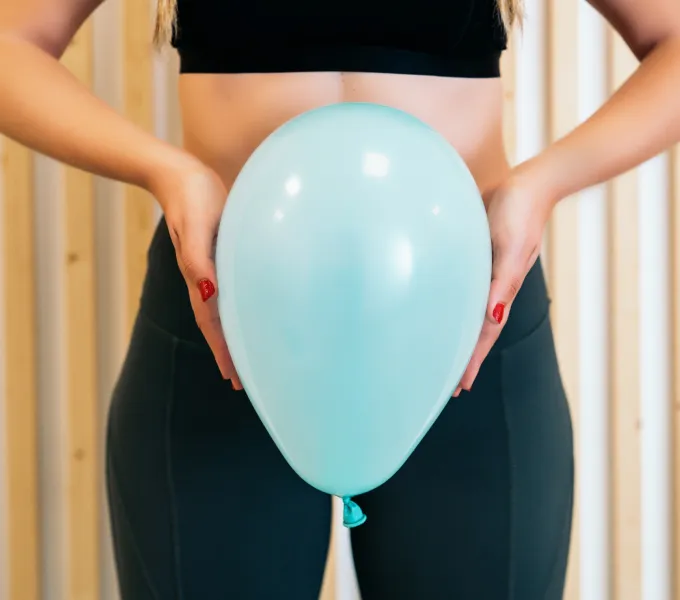
The 1 Pelvic Floor Exercise Everyone Should Do: Diaphragmatic Breathing
As pelvic floor physical therapists, "What's the best exercise for the pelvic floor?" is a question we hear all the time. When it comes to picking one pelvic floor exercise that will benefit absolutely everyone, I can tell you that it’s not yoga or pilates. It’s not a kegel. It’s not using a jade egg (sorry Gwyneth) — it’s diaphragmatic breathing! Yes, breathing techniques for pelvic health. Hear me out.
Your pelvic floor muscles and diaphragm contract and relax opposite each other to facilitate your breath. This means that, just by breathing, you can connect with — and gently move — your pelvic floor muscles.

The ability to connect with and gain control over your pelvic floor muscles is called proprioception. Proprioception is the ability to perceive the position and movement of your body in space.
Proprioception is key to improving the function of any part of the body, including your pelvic floor. And pelvic floor breathing (a.k.a. diaphragmatic or belly breathing) is the first best step to improving your pelvic floor proprioception.
The #1 Pelvic Floor Exercise: Diaphragmatic Breathing
More specifically, this refers to diaphragmatic breathing. This is when you breathe into your belly, allowing it to expand along with your lower ribs — as opposed to breathing into your chest and holding your belly tight.
What’s the Difference? Diaphragmatic Breathing vs. Chest Breathing
Located at the bottom of your rib cage, your diaphragm is the main muscle that helps you breathe. When you inhale, it moves down into your abdominal cavity. At the same time, your pelvic floor drops and lengthens. When you exhale, your diaphragm releases and your pelvic floor shortens, moving back to its resting position. Another way to think about it is that your pelvic floor muscles and diaphragm contract and relax opposite each other like a piston while you inhale and exhale.
You may have also heard diaphragmatic breathing, or pelvic floor breathing, referred to as belly breathing. That’s because the goal of this breathing exercise is to fill the belly with air by breathing all the way into the lower lungs—and in turn activating your pelvic floor.
Chest breathing, on the other hand, is probably a feeling you’re familiar with. It’s also called vertical breathing and refers to breathing into your upper lungs and chest. When you’re chest breathing, you’ll notice that your shoulders rise and fall as you breathe as opposed to your belly and ribs expanding and your pelvic floor and diaphragm producing the piston motions I mentioned earlier.
Although you may feel like you’re breathing deeply, chest breathing does not allow for as deep and full of a breath. It’s often the result of stress or anxiety. Learning how to observe your breath and practice diaphragmatic breathing is not only a great exercise for the pelvic floor, but it also holds many other benefits including regulating your nervous system.
Pelvic floor breathing exercises can be done in any position and during most activities that allow you to breathe calmly.
Connect Your Diaphragm & Pelvic Floor with Every Breath
So why is diaphragmatic breathing the ideal exercise for the pelvic floor? Because the first step to taking care of your pelvic floor is connecting with these muscles and familiarizing yourself with the way they move and function for you.
Pelvic floor breathing is the best way to do this. Also, everyone needs to breathe, so it’s already part of your daily routine. It’s gentle and safe for everyone to do, and it gives you A LOT of information about your body, your pelvic floor, and your tension-holding patterns.
Most importantly, unlike Kegels, diaphragmatic breathing is beneficial for everyone’s pelvic floor muscles. Kegels are an exercise for the pelvic floor that focuses on strengthening. This means they're only helpful if your pelvic floor muscles are weak and lack adequate tension. Many people experience pelvic floor dysfunction because there is too much tension in their pelvic floor muscles, and they need to release it. In this case, doing Kegels is not recommended and could make matters worse. Others need to work on coordinating their pelvic floor muscles. Or you might need all of the above.
How to master diaphragmatic breathing exercises
To make sure you are using the diaphragmatic breathing technique properly to get the most benefit for your pelvic floor, follow these steps:
1. Start on your back with knees bent, feet hip-width apart, and body at rest. Place one hand on your chest, and the other at the top of your abdomen, just under your rib cage.
Tip: let the fingers of the abdominal hand open a bit so that you can feel your bottom ribs and your abdomen at the same time.

2. Inhale, allowing air to fill your belly and low back, then travel all the way into your pelvic floor. Can you feel your pelvic floor expanding away from your body?
Tip: The hand on your chest should remain still, while the other is lifted by your expanding belly. (You may even feel the bottom of your ribs expanding away from each other, and up towards the ceiling along with your abdomen.)
3. Exhale, letting everything settle back into resting position. Can you feel your pelvic floor moving closer to your body?
Continue to breathe in and out in this way.
Depending on what's happening with your pelvic floor, you may or may not be able to feel any movement at first. Be patient and continue to practice and tune into your body. Before long, your connection to your pelvic floor will get stronger.
Want more guidance on connecting with your pelvic floor or having symptoms that you think could be pelvic floor dysfunction? Don't hesitate to connect with a pelvic floor PT. We're here to help!




